Jason Schneider
the Camera Collector
Lovable Losers: Cameras we cherish despite their foibles, part 1
Flawed cameras have their charms—maybe because they’re just like us
By Jason Schneider
Not all cameras are created equal. A small percentage are timeless classics, most are pretty good to very good, a smaller group are mediocre, problematic or both—and then there are the lovable clunkers—cameras beset obvious deficiencies, yet are nevertheless engaging and charming despite, or maybe because of, their obvious deficits. This article is affectionately dedicated to the latter category, and to the forgiving photographers who fall in love with them.
Argus C3: Made by Argus in Ann Arbor, Michigan from 1939 to 1966, the beloved “brick” sold over 3 million units over its long production run, introducing countless Americans to the joys of 35mm photography. Constructed of a great hulking piece of Bakelite plastic embellished with metal castings the C3 has a simple, manually cocked, 3-bladed, behind the lens leaf shutter with speeds of 1/10 to 1/300 sec plus B, which allowed lens interchangeability. Lenses couple to the rangefinder via an external milled wheel that must be removed when switching lenses, a slow, cumbersome procedure, but nevertheless an impressive feature for a low-priced entry level camera (original selling price: $35). The standard lens is a 3-element 50mm f/3.5 Cintar that focuses down to 3 feet. It was made under contract by Bausch & Lomb, Ilex, or Graf Optical Co., varied in quality from quite good to mediocre, and was coated after WWII. Prime lenses from 35mm to 100mm were made for the C3, mostly by Enna Werk and sold under the name Sandmar; others were made in Japan and sold under the Soligor brand. A variety of separate shoe-mount finders were available
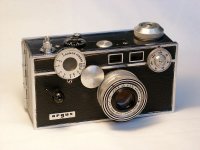
The Beloved Brick: An odd mixture of crudeness and sophistication, the Argus C3 was immensely popular. This is a late postwar version with coated lens.
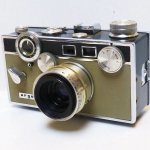
Argus C3 Matchmatic: A handsomely updated version of the classic C3 it used "EV-style" single digits for f/stops and shutter speeds to"aid novices." Boo!
The C3’s elemental frame counter must be manually zeroed and since the film advance isn’t coupled to the shutter cocking mechanism, blank and double exposures are possible. The separate rangefinder and viewfinder windows are dinky but useable and the handy milled focusing wheel overhanging the top may have been inspired by the Zeiss Contax. Attributed to designer Gustave Fassin, the style of the Argus C3 can be charitably described as “imitation precision” but its “scientific look” appealed to Americans, and it came across as a “real camera” despite its relatively primitive specs. It was eventually offered as the C3 Colormatic aimed at novices, with annoying color-coded exposure settings, the handsome 2-tone gray C3 Matchmatic with non-standard single numbered aperture and shutter speed controls, and as the Golden Shield with a snazzy metallized PET (polyethylene terephthalate) coating. Despite its pedestrian provenance the Argus C3 became a cultural icon and was featured in scores of films including The Philadelphia Story (1940) and Harry Potter and the Chamber of Secrets (2002). Back in the day you could load your C3 with Kodachrome, stop it down to f/8, and achieve some remarkably sharp and detailed images. These days you can snag one of these beauties in pristine, working condition for $25-$50; slightly higher for a Matchmatic. It’s no Leica, Nikon, or Canon but it’s retro cool and lots of fun.
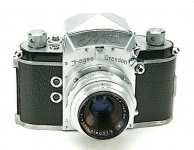
The original Exa of the early '50s is the prettiest of the bunch. It's shown here with standard pre-set 50mm f/2.9 E. Ludwig Meritar, a mediocre triplet.
Exa. The chunky kid sister of the Dresden-made Exakta Varex this adorably compact (but thick) 35mm SLR has a very quiet, low vibration shutter and an Exakta lens mount, the gateway to scores of fascinating lenses. It’s capable of outstanding performance when fitted with any of the great lenses made for the Exakta (Tessar, Biotar, Flektogon, etc.), and it accepts the same waist-level and prism finders as its larger siblings. The bane and glory of the original Exa of 1950-51 is its unique shutter, which is both primitive and sophisticated. It’s essentially a “guillotine shutter” in which the upward rotation of the mirror itself acts as the first (opening) curtain and a curved spring-loaded metal plate hung below the mirror acts as the second or closing blade. While this design is reliable, quiet, and low impact it has two rather serious limitations: it can’t provide either slow or fast speeds, which is why classic Exas provide speeds of 1/25-150 sec (increased to a blistering 1/175 sec on some later models) and it will only accommodate lenses ranging from 35mm to 105mm without noticeable image cutoff. Technically it’s not classic vignetting, but it still annoying, and it’s not visible in the finder!
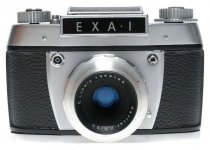
Exa I of 1962-64 had more rounded body, and redesigned controls (such as a regular shutter speed dial) for a more modern look, but the original is prettier.
Like postwar Exaktas, the Exa will not fire when the waist-level finder is closed, and it’s front-mounted shutter release is on the left where it can mate with external auto diaphragm Exakta lenses. The original Exas have a distinctive top mounted “gear shift stick” that moves back and forth in a slot to set shutter speeds, and both wind and rewind are controlled by old fashioned milled knobs. Six distinct versions of the classic Exa were made from 1951-1962, and a new rounded body shape was introduced on the Exa 1 (both versions) of 1962-64. For a complete Exa taxonomy, visit wrotniak.net/photo/exakta/exa-serial.html. Later Exas are interesting and competent cameras, but they lack the elemental charm of versions 1.1 through 1.6. You can glom onto a classic Exa in clean working condition for $50-100 complete with lens (steer clear of the 50mm f/2.8 Meyer Dominar, oner of that company’s few dogs) and make sure the shutter’s working cuz they’re hard to fix.
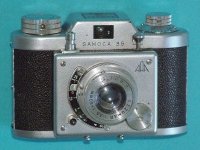
Original Samoca 35 of 1952 is a bare bones scale focusing 35, but it sure is cute. Note front-mounted shutter speed dial and cool "three A's" logo on front.
Samoca 35: For years I thought “Samoca” stood for “same old camera company,” but it really refers to Sanei Sangyo K.K. the Japanese company that made Samoca cameras starting in 1952 and disbanded about 10 years later. “Sanei” means “three A” in Japanese and the cool company logo consists of three A’s forming a triangle. Over the decade of its existence, Samoca produced quite a variety of cameras including coupled rangefinder 35s, models with built-in meters, motors, and autoexposure, and the rare and highly collectible Samocaflex 35 and 35 II, both 35mm twin lens reflexes. However, the most endearing are the simple, unpretentious scale focusing viewfinder 35s, the Samoca 35, 35 II, 35 III, 35 IV and 35 V. All are fitted with decent but unspectacular coated, unit focusing 50mm f/3.5C Ezumar triplet lenses that stop down to f/22 or f/25, have classic milled wind and rewind knobs, manually zeroed frame counters, eyelevel optical finders, removable backs, hinged pressure plates, and flash sync terminals. The original model has no accessory shoe, and all subsequent versions have top-mounted cold shoes. The first 3 models have Vario type shutters with speeds of 1/25-1/100 sec plus B. Models IV and V have Prontor-type shutters with speeds of 1/10-1/200 sec plus B.
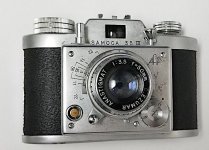
Samoca 35 III of mid '50s is little changed from original model except for minor cosmetic differences. Note depth of field scale on front plate.
What is it that makes the classic scale focusing Samocas so appealing? It’s probably their compact size, neat vintage retro form factor, and “precision mechanical” look. Yes, they can take decent pictures too, but they’re primarily showcase collectibles that embody that bygone era when the Japanese camera industry was just getting on its feet. If you hanker for a scale focusing Samoca, they’re readily available on the major online auction sites at a piddling $25-$50 per copy.
Kodak 35: Elegantly elemental, with ergonomically rounded ends like a Leica, the Kodak 35 of 1938-1951 was Kodak’s first American-made 35mm camera. (The first Kodak 35, The Retina 1, Type 117 of 1934, was made by Kodak AG, Stuttgart, Germany, at the Nagel factory Kodak acquired in 1932.) Developed and manufactured in Rochester, NY, perhaps in anticipation of the impending war that threatened to disrupt imports from Germany, the Kodak 35 is a simple scale focusing camera with a folding optical viewfinder. It has a precision molded Bakelite body with a removable back, satin chrome top and base plates, and handsome knurled metal wind and rewind knobs. The back is removed by turning a wing-type key in the base plate, which also slackens the pressure on the chromed steel pressure plate, a unique arrangement that makes it easier to replace the back.
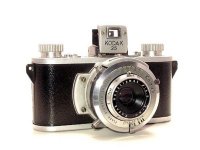
Kodak 35: Introduced in 1938 in anticipation of wartime supply disruptions, it was the first Kodak 35mm camera designed and made in the USA.
Next to the film wind knob, which automatically cocks the shutter when you wind to the next frame, is a manually reset frame counter with a release button that can easily be mistaken for the shutter release. The actual shutter release is rearward pointing pin attached to the shutter release lever located at about 10 o-clock in the shutter housing. The front cell focusing lens is rigidly mounted in a Kodak-made leaf shutter, and a variety of lens/shutter combinations were available: a 3-element 50mm f/5.6 Kodak Anastigmat in a Kodex shutter; a 4-element 51mm f/3.5 Kodak Anastigmat Special (a Tessar type) in a Kodamatic or Flash Kodamatic shutter, and a 50mm f/4.5 Kodak Anastigmat or Anaston (both triplets) in a Flash Diomatic shutter. The frame counter mechanism prevents double exposures but not blank exposures. However, a red indicator in a slot atop the shutter housing confirms that the film has been advanced, and the shutter is cocked—a nice touch. The most common shutter speed range was 1/25, 150, 1/100 and 1/150 sec plus B and T and all Kodamatic shutters have built in mechanical self-timers. The lenses focus about 3-1/2 ft. (the closest marked distance is 4 ft.) and they stop down to f/16.
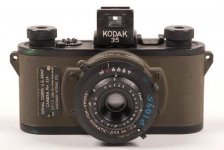
U.S. Army Signal Corps version of the Kodak 35 with olive drab covering, black finish, and military markings is a collector's prize and priced accordingly.
The Kodak 35 is a very pleasant camera to shoot with despite, or maybe because of, its bare bones simplicity, and it’s capable of impressive on-film results, especially models fitted with the outstanding 51mm f/3.5 Kodak Anastigmat Special lens. Standard civilian Kodak 35s have some collector appeal and fetch $60-$125 in clean working condition. Military models in olive drab and black with military markings fetch fancy prices in the $300-$500 range.
Kodak 35 Rangefinder: About 2 years after introducing the scale focusing Kodak 35 in 1938, the company brought forth an ungainly coupled rangefinder version, based on the same basic body. It was probably intended to complete with the mighty Argus C3, which has a coupled rangefinder. Also engraved “KODAK 35” it’s generally known as the Kodak 35 Rangefinder or Kodak 35 RF and it’s basically a Kodak 35 with a new top housing that contains a centrally placed optical viewfinder, a separate long base rangefinder, and separate viewfinder and rangefinder eyepieces on the back. The lens still focuses by moving the front element, but a toothed wheel mates with the geared front lens ring to relay the amount of front element extension to the rangefinder optics via an external mechanism hidden inside a metal protrusion extending below the small rangefinder window on the rewind side. This “Rube Goldberg” arrangement was needed to graft a coupled rangefinder onto an existing camera, and it resulted in one of the ugliest rangefinder 35s that Kodak, or anyone else, ever made! However, this ugly duckling has its charms, and it performs quite well.
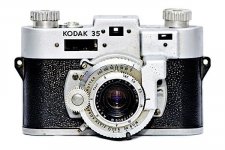
Kodak 35 Rangefinder: A nice camera, but hardly a thing of beauty, it debuted at the end of '39. This late version with coated Anastar lens dates from 1951.
Like the Kodak 35, the Kokak 35 Rangefinder was offered with a variety of lens/shutter combos and with minor external and internal variations, but almost all of them are fitted with the excellent 51mm f/3.5 Kodak Anastigmat Special, or 50mm f/3.5 Anastar Special lens, both front-cell- focusing Tessar types that focus to 3 feet, 6 inches and stop down to f/16. Shutters include the Kodamatic and Flash Kodamatic, both providing speeds of 1/10, 1/25, 1/50. 1/100 and 1/200 sec plus B and T and incorporating built-in self-timers. Sadly, the Kodak 35 RF was phased out in 1951, but they’re readily available used in clean working condition at $25-50 on the leading auction sites.
Kodak Pony 135: Designed by Arthur H. Crapsey for Eastman Kodak Co., these endearing plastic-bodied scale focusing 35s were aimed at novices moving up from the roll film Brownies but not quite ready for the Kodak Signets, which were targeted at more serious enthusiasts. Produced from 1949 to 1961 they have simple optical viewfinders, knob wind and rewind, front-cell-focusing lenses, manually cocked, variable speed shutters (on all but the Pony II), and a shutter release/film advance interlock to prevent double exposures that can be overridden with a bypass switch. There was also an 828 version of 1949-1959 with no rewind knob that took 35mm-wide 828 roll film.
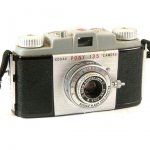
Kodak Pony 135 of 1950-1954 with (collapsed) 51mm f/4.5 Anaston triplet lens in Kodak Flash 200 shutter was a popular step-up from the roll film Kodak Brownies.
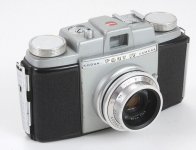
Kodak Pony IV: Last and best of the bunch, it has a 4-element 44mm f/3.5 Anastar lens in a Kodak Flash 250 shutter. Setting the exposure is a pain (see text).
The original Pony 135 of 1950-1954 has a collapsible 3-element 51mm f/4.5 Anaston lens in a Kodak Flash 200 1/8-1/200 sec plus B shutter. The Pony Model B (1953-1955) is almost identical to the original, but its slowest shutter speed is 1/25 sec; the Pony Model C of 1955-1958 has a rigidly mounted 44mm f/3.5 Kodak Anaston lens and a Kodak Flash 300 1/25-1/300 sec plus B shutter and a red/brown Bakelite body. The apex of the Pony line is the Pony IV of 1957-1961, which has a 4-element Tessar type 44mm f/3.5 Kodak Anastar lens and a Kodak Flash 250 shutter with speeds of 1/30, 1/60, 1/125, and 1/250 sec plus B. It’s the only Pony with an accessory shoe, but also has those wretched single- digit “EV-related” numbers in place of apertures and shutter speeds. Fortunately the conventional settings are (inconveniently) displayed in the underside of the lens mount (lots of luck setting the exposure with the camera atop a tripod).
You can acquire a clean working example of one of these charmingly unpretentious little gems at all the usual places for a piddling $20-$35; sometimes even less!
Ciro-flex: A series of elemental 2-1/4 x 2-1/4-inch twin lens reflexes made by Ciro, originally in Detroit, Michigan starting in 1941, and in Delaware, Ohio starting around 1947, they continued as the Graflex 22 with cosmetic changes when the company was later acquired by Graflex. All make 12 exposures per roll on 120 roll film, have Wollensak lenses and shutters, simple snail cam focusing lens boards, and unregenerate red window frame counters using the numbers on the paper film backing. At least there’s a rotating red window cover built into the back and a cute little lever for erecting the waist level finder, but otherwise this is a no-frills TLR. The models range very logically from A, B, C, D, E to the top-of-the-line F. The Ciro-flex F is the only one with a 4-element, Tessar type 83mm f/3.2 Wollensak Raptar lens, a 1-1/400 sec plus B and T Rapax shutter and MFX sync, and either a plain or Fresnel viewing screen.
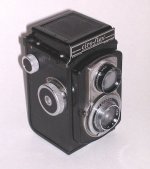
Ciroflex A of the late '40s: It has an 85mm f/3.5 Wollensak Anastigmat lens in an Alphax 1/10-1/200 sec plus B &T shutter and is a competent picture taker.
All other models had 3-element 85mm f/3.5 Wollensak Anastigmat lenses, the slightly longer than normal focal length helping to ensure sharpness in the corners at wide apertures. Models A and B had Alphax 1/10-1/200 sec plus B & T shutters. The Ciro-flex C had a plain ground glass screen, a parallax correcting viewfinder, and an 85mm f/3.5 triplet lens; the Ciro-flex E added a Fresnel bright screen finder but deleted the parallax compensation.
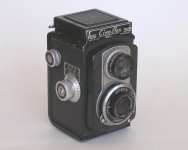
Ciroflex C: This model has parallax compensation like the Rolleis and a 1-1/400sec Rapax shutter, but the lens is an 85mm f/3.5 Wollensak Anastigmat, a decent triplet.
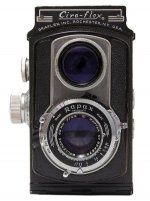
Ciroflex F: The top of the line model, it was fitted with a superb 4-element 83mm f/3.2 Wollensak Raptar lens in a Rapax 1-1/400 sec plus B & T shutter.
While they’re a lot more primitive than, say, a Rolleiflex or Ikoflex, Ciro-flexes are well made in a workmanlike American way and are generally reliable and durable since there’s nothing much to go wrong. They’re also competent picture takers—even the ones with 3-element lenses—and especially the model F, which is outstanding. The viewing image is reasonably bright, contrasty, and useable but doesn’t compare to a modern TLR like a late model Rollei or Mamiya. The Fresnel screen in some later models is better, and a model F with a Fresnel screen (unlike mine, alas!) would be your best shooting option. Ciro-flexes in nice shape are readily available at prices ranging from $35-S100 except for the desirable Ciro-flex F which fetches $150-$250 if you can find one.
Flawed cameras have their charms—maybe because they’re just like us
By Jason Schneider
Not all cameras are created equal. A small percentage are timeless classics, most are pretty good to very good, a smaller group are mediocre, problematic or both—and then there are the lovable clunkers—cameras beset obvious deficiencies, yet are nevertheless engaging and charming despite, or maybe because of, their obvious deficits. This article is affectionately dedicated to the latter category, and to the forgiving photographers who fall in love with them.
Argus C3: Made by Argus in Ann Arbor, Michigan from 1939 to 1966, the beloved “brick” sold over 3 million units over its long production run, introducing countless Americans to the joys of 35mm photography. Constructed of a great hulking piece of Bakelite plastic embellished with metal castings the C3 has a simple, manually cocked, 3-bladed, behind the lens leaf shutter with speeds of 1/10 to 1/300 sec plus B, which allowed lens interchangeability. Lenses couple to the rangefinder via an external milled wheel that must be removed when switching lenses, a slow, cumbersome procedure, but nevertheless an impressive feature for a low-priced entry level camera (original selling price: $35). The standard lens is a 3-element 50mm f/3.5 Cintar that focuses down to 3 feet. It was made under contract by Bausch & Lomb, Ilex, or Graf Optical Co., varied in quality from quite good to mediocre, and was coated after WWII. Prime lenses from 35mm to 100mm were made for the C3, mostly by Enna Werk and sold under the name Sandmar; others were made in Japan and sold under the Soligor brand. A variety of separate shoe-mount finders were available

The Beloved Brick: An odd mixture of crudeness and sophistication, the Argus C3 was immensely popular. This is a late postwar version with coated lens.

Argus C3 Matchmatic: A handsomely updated version of the classic C3 it used "EV-style" single digits for f/stops and shutter speeds to"aid novices." Boo!
The C3’s elemental frame counter must be manually zeroed and since the film advance isn’t coupled to the shutter cocking mechanism, blank and double exposures are possible. The separate rangefinder and viewfinder windows are dinky but useable and the handy milled focusing wheel overhanging the top may have been inspired by the Zeiss Contax. Attributed to designer Gustave Fassin, the style of the Argus C3 can be charitably described as “imitation precision” but its “scientific look” appealed to Americans, and it came across as a “real camera” despite its relatively primitive specs. It was eventually offered as the C3 Colormatic aimed at novices, with annoying color-coded exposure settings, the handsome 2-tone gray C3 Matchmatic with non-standard single numbered aperture and shutter speed controls, and as the Golden Shield with a snazzy metallized PET (polyethylene terephthalate) coating. Despite its pedestrian provenance the Argus C3 became a cultural icon and was featured in scores of films including The Philadelphia Story (1940) and Harry Potter and the Chamber of Secrets (2002). Back in the day you could load your C3 with Kodachrome, stop it down to f/8, and achieve some remarkably sharp and detailed images. These days you can snag one of these beauties in pristine, working condition for $25-$50; slightly higher for a Matchmatic. It’s no Leica, Nikon, or Canon but it’s retro cool and lots of fun.

The original Exa of the early '50s is the prettiest of the bunch. It's shown here with standard pre-set 50mm f/2.9 E. Ludwig Meritar, a mediocre triplet.
Exa. The chunky kid sister of the Dresden-made Exakta Varex this adorably compact (but thick) 35mm SLR has a very quiet, low vibration shutter and an Exakta lens mount, the gateway to scores of fascinating lenses. It’s capable of outstanding performance when fitted with any of the great lenses made for the Exakta (Tessar, Biotar, Flektogon, etc.), and it accepts the same waist-level and prism finders as its larger siblings. The bane and glory of the original Exa of 1950-51 is its unique shutter, which is both primitive and sophisticated. It’s essentially a “guillotine shutter” in which the upward rotation of the mirror itself acts as the first (opening) curtain and a curved spring-loaded metal plate hung below the mirror acts as the second or closing blade. While this design is reliable, quiet, and low impact it has two rather serious limitations: it can’t provide either slow or fast speeds, which is why classic Exas provide speeds of 1/25-150 sec (increased to a blistering 1/175 sec on some later models) and it will only accommodate lenses ranging from 35mm to 105mm without noticeable image cutoff. Technically it’s not classic vignetting, but it still annoying, and it’s not visible in the finder!

Exa I of 1962-64 had more rounded body, and redesigned controls (such as a regular shutter speed dial) for a more modern look, but the original is prettier.
Like postwar Exaktas, the Exa will not fire when the waist-level finder is closed, and it’s front-mounted shutter release is on the left where it can mate with external auto diaphragm Exakta lenses. The original Exas have a distinctive top mounted “gear shift stick” that moves back and forth in a slot to set shutter speeds, and both wind and rewind are controlled by old fashioned milled knobs. Six distinct versions of the classic Exa were made from 1951-1962, and a new rounded body shape was introduced on the Exa 1 (both versions) of 1962-64. For a complete Exa taxonomy, visit wrotniak.net/photo/exakta/exa-serial.html. Later Exas are interesting and competent cameras, but they lack the elemental charm of versions 1.1 through 1.6. You can glom onto a classic Exa in clean working condition for $50-100 complete with lens (steer clear of the 50mm f/2.8 Meyer Dominar, oner of that company’s few dogs) and make sure the shutter’s working cuz they’re hard to fix.

Original Samoca 35 of 1952 is a bare bones scale focusing 35, but it sure is cute. Note front-mounted shutter speed dial and cool "three A's" logo on front.
Samoca 35: For years I thought “Samoca” stood for “same old camera company,” but it really refers to Sanei Sangyo K.K. the Japanese company that made Samoca cameras starting in 1952 and disbanded about 10 years later. “Sanei” means “three A” in Japanese and the cool company logo consists of three A’s forming a triangle. Over the decade of its existence, Samoca produced quite a variety of cameras including coupled rangefinder 35s, models with built-in meters, motors, and autoexposure, and the rare and highly collectible Samocaflex 35 and 35 II, both 35mm twin lens reflexes. However, the most endearing are the simple, unpretentious scale focusing viewfinder 35s, the Samoca 35, 35 II, 35 III, 35 IV and 35 V. All are fitted with decent but unspectacular coated, unit focusing 50mm f/3.5C Ezumar triplet lenses that stop down to f/22 or f/25, have classic milled wind and rewind knobs, manually zeroed frame counters, eyelevel optical finders, removable backs, hinged pressure plates, and flash sync terminals. The original model has no accessory shoe, and all subsequent versions have top-mounted cold shoes. The first 3 models have Vario type shutters with speeds of 1/25-1/100 sec plus B. Models IV and V have Prontor-type shutters with speeds of 1/10-1/200 sec plus B.

Samoca 35 III of mid '50s is little changed from original model except for minor cosmetic differences. Note depth of field scale on front plate.
What is it that makes the classic scale focusing Samocas so appealing? It’s probably their compact size, neat vintage retro form factor, and “precision mechanical” look. Yes, they can take decent pictures too, but they’re primarily showcase collectibles that embody that bygone era when the Japanese camera industry was just getting on its feet. If you hanker for a scale focusing Samoca, they’re readily available on the major online auction sites at a piddling $25-$50 per copy.
Kodak 35: Elegantly elemental, with ergonomically rounded ends like a Leica, the Kodak 35 of 1938-1951 was Kodak’s first American-made 35mm camera. (The first Kodak 35, The Retina 1, Type 117 of 1934, was made by Kodak AG, Stuttgart, Germany, at the Nagel factory Kodak acquired in 1932.) Developed and manufactured in Rochester, NY, perhaps in anticipation of the impending war that threatened to disrupt imports from Germany, the Kodak 35 is a simple scale focusing camera with a folding optical viewfinder. It has a precision molded Bakelite body with a removable back, satin chrome top and base plates, and handsome knurled metal wind and rewind knobs. The back is removed by turning a wing-type key in the base plate, which also slackens the pressure on the chromed steel pressure plate, a unique arrangement that makes it easier to replace the back.

Kodak 35: Introduced in 1938 in anticipation of wartime supply disruptions, it was the first Kodak 35mm camera designed and made in the USA.
Next to the film wind knob, which automatically cocks the shutter when you wind to the next frame, is a manually reset frame counter with a release button that can easily be mistaken for the shutter release. The actual shutter release is rearward pointing pin attached to the shutter release lever located at about 10 o-clock in the shutter housing. The front cell focusing lens is rigidly mounted in a Kodak-made leaf shutter, and a variety of lens/shutter combinations were available: a 3-element 50mm f/5.6 Kodak Anastigmat in a Kodex shutter; a 4-element 51mm f/3.5 Kodak Anastigmat Special (a Tessar type) in a Kodamatic or Flash Kodamatic shutter, and a 50mm f/4.5 Kodak Anastigmat or Anaston (both triplets) in a Flash Diomatic shutter. The frame counter mechanism prevents double exposures but not blank exposures. However, a red indicator in a slot atop the shutter housing confirms that the film has been advanced, and the shutter is cocked—a nice touch. The most common shutter speed range was 1/25, 150, 1/100 and 1/150 sec plus B and T and all Kodamatic shutters have built in mechanical self-timers. The lenses focus about 3-1/2 ft. (the closest marked distance is 4 ft.) and they stop down to f/16.

U.S. Army Signal Corps version of the Kodak 35 with olive drab covering, black finish, and military markings is a collector's prize and priced accordingly.
The Kodak 35 is a very pleasant camera to shoot with despite, or maybe because of, its bare bones simplicity, and it’s capable of impressive on-film results, especially models fitted with the outstanding 51mm f/3.5 Kodak Anastigmat Special lens. Standard civilian Kodak 35s have some collector appeal and fetch $60-$125 in clean working condition. Military models in olive drab and black with military markings fetch fancy prices in the $300-$500 range.
Kodak 35 Rangefinder: About 2 years after introducing the scale focusing Kodak 35 in 1938, the company brought forth an ungainly coupled rangefinder version, based on the same basic body. It was probably intended to complete with the mighty Argus C3, which has a coupled rangefinder. Also engraved “KODAK 35” it’s generally known as the Kodak 35 Rangefinder or Kodak 35 RF and it’s basically a Kodak 35 with a new top housing that contains a centrally placed optical viewfinder, a separate long base rangefinder, and separate viewfinder and rangefinder eyepieces on the back. The lens still focuses by moving the front element, but a toothed wheel mates with the geared front lens ring to relay the amount of front element extension to the rangefinder optics via an external mechanism hidden inside a metal protrusion extending below the small rangefinder window on the rewind side. This “Rube Goldberg” arrangement was needed to graft a coupled rangefinder onto an existing camera, and it resulted in one of the ugliest rangefinder 35s that Kodak, or anyone else, ever made! However, this ugly duckling has its charms, and it performs quite well.

Kodak 35 Rangefinder: A nice camera, but hardly a thing of beauty, it debuted at the end of '39. This late version with coated Anastar lens dates from 1951.
Like the Kodak 35, the Kokak 35 Rangefinder was offered with a variety of lens/shutter combos and with minor external and internal variations, but almost all of them are fitted with the excellent 51mm f/3.5 Kodak Anastigmat Special, or 50mm f/3.5 Anastar Special lens, both front-cell- focusing Tessar types that focus to 3 feet, 6 inches and stop down to f/16. Shutters include the Kodamatic and Flash Kodamatic, both providing speeds of 1/10, 1/25, 1/50. 1/100 and 1/200 sec plus B and T and incorporating built-in self-timers. Sadly, the Kodak 35 RF was phased out in 1951, but they’re readily available used in clean working condition at $25-50 on the leading auction sites.
Kodak Pony 135: Designed by Arthur H. Crapsey for Eastman Kodak Co., these endearing plastic-bodied scale focusing 35s were aimed at novices moving up from the roll film Brownies but not quite ready for the Kodak Signets, which were targeted at more serious enthusiasts. Produced from 1949 to 1961 they have simple optical viewfinders, knob wind and rewind, front-cell-focusing lenses, manually cocked, variable speed shutters (on all but the Pony II), and a shutter release/film advance interlock to prevent double exposures that can be overridden with a bypass switch. There was also an 828 version of 1949-1959 with no rewind knob that took 35mm-wide 828 roll film.

Kodak Pony 135 of 1950-1954 with (collapsed) 51mm f/4.5 Anaston triplet lens in Kodak Flash 200 shutter was a popular step-up from the roll film Kodak Brownies.

Kodak Pony IV: Last and best of the bunch, it has a 4-element 44mm f/3.5 Anastar lens in a Kodak Flash 250 shutter. Setting the exposure is a pain (see text).
The original Pony 135 of 1950-1954 has a collapsible 3-element 51mm f/4.5 Anaston lens in a Kodak Flash 200 1/8-1/200 sec plus B shutter. The Pony Model B (1953-1955) is almost identical to the original, but its slowest shutter speed is 1/25 sec; the Pony Model C of 1955-1958 has a rigidly mounted 44mm f/3.5 Kodak Anaston lens and a Kodak Flash 300 1/25-1/300 sec plus B shutter and a red/brown Bakelite body. The apex of the Pony line is the Pony IV of 1957-1961, which has a 4-element Tessar type 44mm f/3.5 Kodak Anastar lens and a Kodak Flash 250 shutter with speeds of 1/30, 1/60, 1/125, and 1/250 sec plus B. It’s the only Pony with an accessory shoe, but also has those wretched single- digit “EV-related” numbers in place of apertures and shutter speeds. Fortunately the conventional settings are (inconveniently) displayed in the underside of the lens mount (lots of luck setting the exposure with the camera atop a tripod).
You can acquire a clean working example of one of these charmingly unpretentious little gems at all the usual places for a piddling $20-$35; sometimes even less!
Ciro-flex: A series of elemental 2-1/4 x 2-1/4-inch twin lens reflexes made by Ciro, originally in Detroit, Michigan starting in 1941, and in Delaware, Ohio starting around 1947, they continued as the Graflex 22 with cosmetic changes when the company was later acquired by Graflex. All make 12 exposures per roll on 120 roll film, have Wollensak lenses and shutters, simple snail cam focusing lens boards, and unregenerate red window frame counters using the numbers on the paper film backing. At least there’s a rotating red window cover built into the back and a cute little lever for erecting the waist level finder, but otherwise this is a no-frills TLR. The models range very logically from A, B, C, D, E to the top-of-the-line F. The Ciro-flex F is the only one with a 4-element, Tessar type 83mm f/3.2 Wollensak Raptar lens, a 1-1/400 sec plus B and T Rapax shutter and MFX sync, and either a plain or Fresnel viewing screen.

Ciroflex A of the late '40s: It has an 85mm f/3.5 Wollensak Anastigmat lens in an Alphax 1/10-1/200 sec plus B &T shutter and is a competent picture taker.
All other models had 3-element 85mm f/3.5 Wollensak Anastigmat lenses, the slightly longer than normal focal length helping to ensure sharpness in the corners at wide apertures. Models A and B had Alphax 1/10-1/200 sec plus B & T shutters. The Ciro-flex C had a plain ground glass screen, a parallax correcting viewfinder, and an 85mm f/3.5 triplet lens; the Ciro-flex E added a Fresnel bright screen finder but deleted the parallax compensation.

Ciroflex C: This model has parallax compensation like the Rolleis and a 1-1/400sec Rapax shutter, but the lens is an 85mm f/3.5 Wollensak Anastigmat, a decent triplet.

Ciroflex F: The top of the line model, it was fitted with a superb 4-element 83mm f/3.2 Wollensak Raptar lens in a Rapax 1-1/400 sec plus B & T shutter.
While they’re a lot more primitive than, say, a Rolleiflex or Ikoflex, Ciro-flexes are well made in a workmanlike American way and are generally reliable and durable since there’s nothing much to go wrong. They’re also competent picture takers—even the ones with 3-element lenses—and especially the model F, which is outstanding. The viewing image is reasonably bright, contrasty, and useable but doesn’t compare to a modern TLR like a late model Rollei or Mamiya. The Fresnel screen in some later models is better, and a model F with a Fresnel screen (unlike mine, alas!) would be your best shooting option. Ciro-flexes in nice shape are readily available at prices ranging from $35-S100 except for the desirable Ciro-flex F which fetches $150-$250 if you can find one.
Mackinaw
Think Different
Glad you mentioned the Argus. My dad bought the "Brick" back in the 50's and took hundreds of Kodachrome slides, all that I still have, that look like they were taken yesterday. Great camera that made great memories.
Jim B.
Jim B.
KoNickon
Nick Merritt
That woefully slow top shutter speed of the early Exas is just odd. (And mine caps at 1/175th anyway.) I guess back then, when fast film was uncommon, this wasn't a big deal. But still, to have 1/150 and then 1/175? Why bother? They really are cute little critters, though.
Jason Schneider
the Camera Collector
Glad you mentioned the Argus. My dad bought the "Brick" back in the 50's and took hundreds of Kodachrome slides, all that I still have, that look like they were taken yesterday. Great camera that made great memories.
Jim B.
Glad you liked the piece, and thanks for your fond memories your dad's Argus C3. Warning: Kodachrome slides will look like they were shot yesterday only if you NEVER project them ( at least not the originals) store them in their original boxes or in a completely dark place at cool or moderate temperatures (40-50 degrees F if possible), and at low to moderate humidity. In short, the dark stability of Kodachrome (all types) is very good, but their light stability is not so hot, perhaps even below average.
Vince Lupo
Nobody's Mentor
One nice thing about the original Exa is that you never have to worry about getting pinholes in the shutter 
besk
Well-known
My first camera was the Pony IV. Had to have a 35mm camera. Paid $44.00 for it new at the local drug store in my small town.
Still have the camera and most of the negatives - including Kodachrome slides.
Still have the camera and most of the negatives - including Kodachrome slides.
oftheherd
Mentor
Thanks. I always enjoy your posts and this was no exception. My father never bought any of the cameras you mentioned, at least to my recollection. He did buy some cheap plastic camera to cut the lens off of it so he could mount it to the back of a 9x12 camera. I don't remember what film it used now, I would have to look when I am around it again. He did use a Welta Welti. But I have known about several of the cameras you mentioned. If fact, I seem to remember some of the members here mentioning using a Ciroflex.
The one that interested me most was the Kodak 35 for the US Army. I had no idea they bought and used them circa WWII. I know post war they used Leicas for 35mm and Graflex for 4x5.
But thanks again for you article that not only shows the cameras, but your knowledge to be able to comment on them.
The one that interested me most was the Kodak 35 for the US Army. I had no idea they bought and used them circa WWII. I know post war they used Leicas for 35mm and Graflex for 4x5.
But thanks again for you article that not only shows the cameras, but your knowledge to be able to comment on them.
Mackinaw
Think Different
Glad you liked the piece, and thanks for your fond memories your dad's Argus C3. Warning: Kodachrome slides will look like they were shot yesterday only if you NEVER project them ( at least not the originals) store them in their original boxes or in a completely dark place at cool or moderate temperatures (40-50 degrees F if possible), and at low to moderate humidity. In short, the dark stability of Kodachrome (all types) is very good, but their its stability is not so hot, perhaps even below average.
No chance that I'll be projecting these old Kodachromes. I don't even have a projector. All the transparencies have been scanned, and they'll spend the rest of their lives in their original boxes. I honestly think that most of these 1950's slides were viewed once or twice by the family back in 1954 (or whatever), put back in their boxes where they sat for 60 years until I rediscovered them. Ideal storage conditions are the reason that look like they were shot yesterday.
Jim B.
Jason Schneider
the Camera Collector
One nice thing about the original Exa is that you never have to worry about getting pinholes in the shutter
Quite right--and that's more than you can say for Exaktas, especially postwar models from the early '50s!
pvdhaar
Peter
Nice read, looking forward to part 2
My parents used to have a Kodak 35. One of its weak points not mentioned is that the folding viewfinder would easily break off.
My parents used to have a Kodak 35. One of its weak points not mentioned is that the folding viewfinder would easily break off.
p.giannakis
Pan Giannakis
When I saw the title "Lovable Losers " I though it was an article about the Zenit EM.
With the exception of the Exacta and the Pony, I haven't seen any of the other cameras in charity shops/car boots in UK. They were probably aimed at the American market mostly.
looking forward to Part 2.
With the exception of the Exacta and the Pony, I haven't seen any of the other cameras in charity shops/car boots in UK. They were probably aimed at the American market mostly.
looking forward to Part 2.
raydm6
Yay! Cameras! 🙈🙉🙊┌( ಠ_ಠ)┘ [◉"]
Nice article Jason Schneider.
I have a brick and some EXA's (prices have really climbed recently).
That's an interesting tidbit about the Cintar lens makers:
I have a brick and some EXA's (prices have really climbed recently).
That's an interesting tidbit about the Cintar lens makers:
The standard lens is a 3-element 50mm f/3.5 Cintar that focuses down to 3 feet. It was made under contract by Bausch & Lomb, Ilex, or Graf Optical Co., varied in quality from quite good to mediocre, and was coated after WWII.
Muggins
Junk magnet
When I saw the title "Lovable Losers " I though it was an article about the Zenit EM.
With the exception of the Exacta and the Pony, I haven't seen any of the other cameras in charity shops/car boots in UK. They were probably aimed at the American market mostly.
looking forward to Part 2.
I do have a brick - a Matchmatic, no less - bought at a UK junk market (I didn't pick the Harry Potter connection, despite having seen the movie and wondering what the camera was...). It was the gearing that appealed to me - my first thought was "Traction engine!". It has its charms, especially when only brought out every few years - something of an exercise in masochism!
They are pretty rare here, despite the number of US servicemen here in days of yore. I've seen maybe half a dozen. I did see a chap who was going to parachute from a C47 into Normandy for the 75th anniversary of D-Day toting one - I just hope he didn't land on it, because those corners hurt!
I'd put a number of 1930s folders into the list, it seems to have been the era of the weirdly located shutter release, and any votes for the Werra's wind-on mech?
Mr_Flibble
In Tabulas Argenteas Refero
The one that interested me most was the Kodak 35 for the US Army. I had no idea they bought and used them circa WWII. I know post war they used Leicas for 35mm and Graflex for 4x5.
The US Army used "Anniversary" Speed Graphics 4x5 during the war and post-1947 they switched to Pacemaker models.
The Leica III or IIIa was an unofficially adopted 35mm camera during the war. According to the Table of Organisation & Equipment for the Signal Photographic Companies. Each company being issued 13 Leicas...on paper. And they were mainly carried by officers.
The green Kodak 35, designated the PH-324, was part of PH-261 Photographic Set (a Kodak Portable Miniature Enlarger and other Dark Room equipment in single box). In the set they were used to copy documents to microfilm and such). In the field they did show up in the hands of identification units of the Signal Photographic Companies. Also in the hands of GIs out on leave.
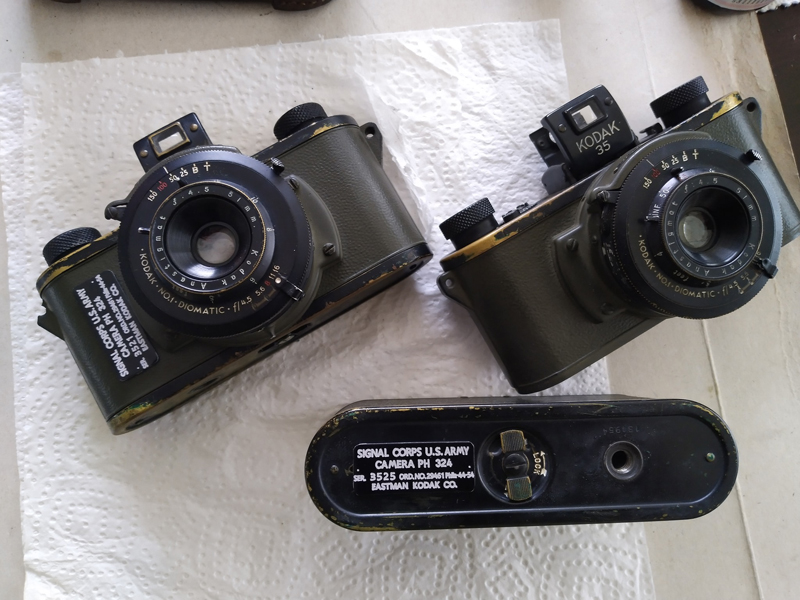
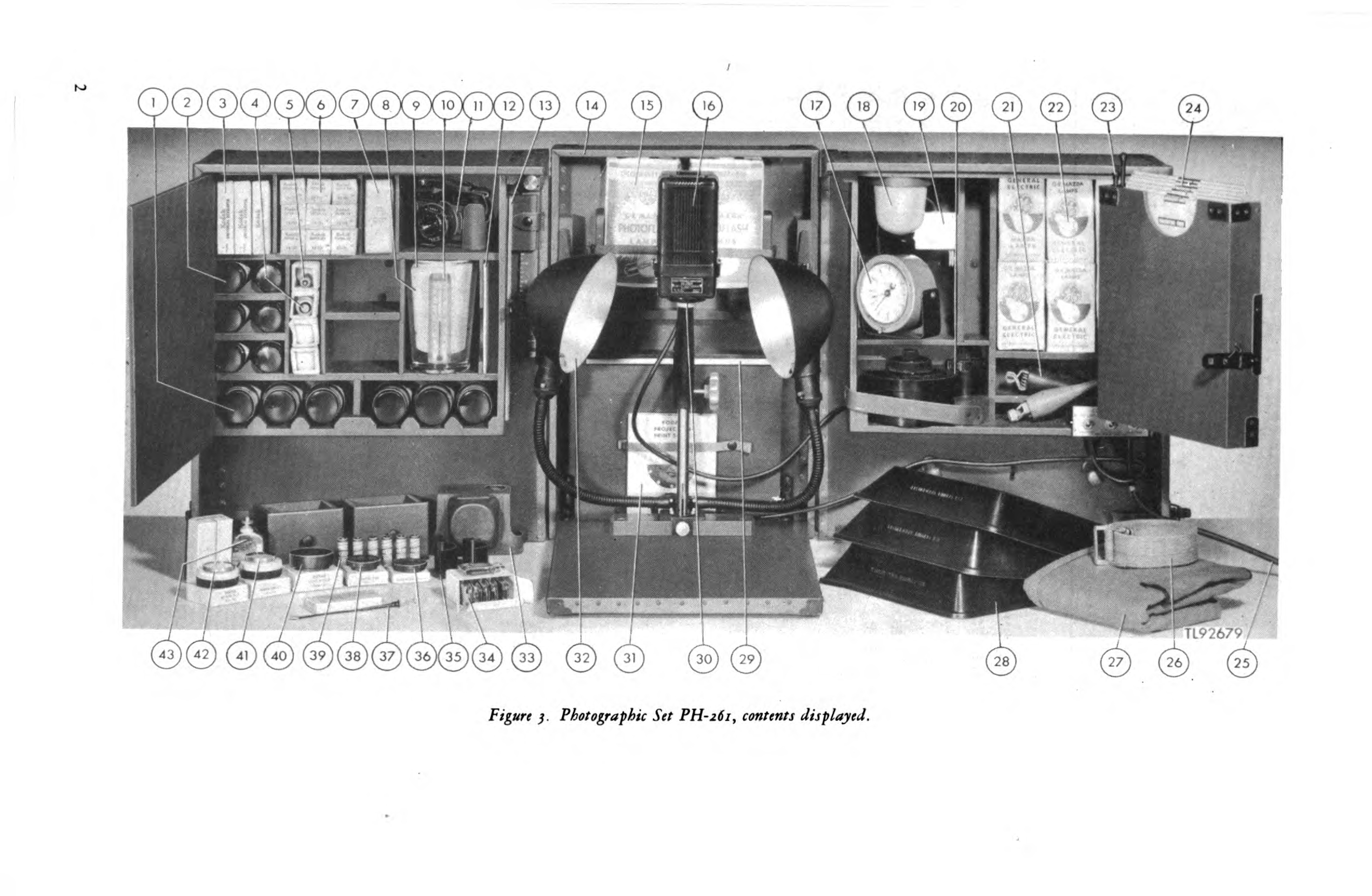
Last edited:
neal3k
Well-known
What a delightful article (and nice follow-up by Mr Fibble.) I've been using (sporadically) an early Exa since the late 60s when I bought one to go with my gifted Exakta VX. The Exa is still fine and the Exakta has pinholes. I bought an ugly version Kodak 35 earlier this year and later paired it with the folding viewfinder version. Both are fun and weird but the ugly version is the one likely to stay home. I've had an Argus Matchmatic on the shelf for a few years, decided to try it out a few months ago, and hated it. But last month I bought a 1947 C3 and clunky as it is, it is quite fun to shoot.
Now you have me interested in a Samoca. Thanks for the story and the new temptations.
Now you have me interested in a Samoca. Thanks for the story and the new temptations.
oftheherd
Mentor
The US Army used "Anniversary" Speed Graphics 4x5 during the war and post-1947 they switched to Pacemaker models.
The Leica III or IIIa was an unofficially adopted 35mm camera during the war. According to the Table of Organisation & Equipment for the Signal Photographic Companies. Each company being issued 13 Leicas...on paper. And they were mainly carried by officers.
The green Kodak 35, designated the PH-324, was part of PH-261 Photographic Set (a Kodak Portable Miniature Enlarger and other Dark Room equipment in single box). In the set they were used to copy documents to microfilm and such). In the field they did show up in the hands of identification units of the Signal Photographic Companies. Also in the hands of GIs out on leave.
Thanks very much for the info. That was a fascinating read.
Mr_Flibble
In Tabulas Argenteas Refero
Thanks very much for the info. That was a fascinating read.
I'm in the middle of rebuilding one of these PH-261 kits for display purposes. Picked up the empty case last summer. I'm still missing quite a few bits to complete it.
oftheherd
Mentor
Yes, I would expect after all this time it would really be difficult to find such things now. Good luck.
JeffS7444
Well-known
I had no idea that Exas were smaller than regular Exakta models, and that makes Exa very interesting to me, along with Rolleiflex 4x4.
raydm6
Yay! Cameras! 🙈🙉🙊┌( ಠ_ಠ)┘ [◉"]
I had no idea that Exas were smaller than regular Exakta models, and that makes Exa very interesting to me, along with Rolleiflex 4x4.
They are small but a little chubby. I think they’re kinda cute.
Jason had two articles on them in case you missed them: And Stephen’s thread is a fun read:
https://www.rangefinderforum.com/node/176718
Share:
-
This site uses cookies to help personalise content, tailor your experience and to keep you logged in if you register.
By continuing to use this site, you are consenting to our use of cookies.

